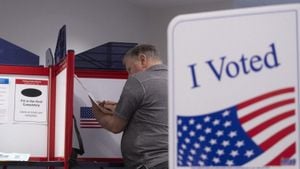Ohio's electoral integrity has come under fire recently with two events casting shadows over the voting process: new demands for voter identification and the bizarre indictment of a deceased man for voting illegally. Together, these incidents form the backdrop for troubling discussions about voting rights and the potential for disenfranchisement.
On October 22, 2024, Ohio Attorney General Dave Yost announced the indictment of six individuals, all of whom were alleged to have voted illegally, according to the controversial findings of Secretary of State Frank LaRose. The situation took on an absurd twist when it was revealed one of those indicted, Ramesh Patel, had passed away two years prior.
The indictment, showcased during Yost's press conference less than two weeks before Election Day, aimed at making headlines but, instead, raised questions about the motives behind such prosecutions. Yost, along with LaRose, has been criticized for employing tactics reminiscent of politically charged witch hunts, promoting the notion of rampant illegal voting when, according to Yost himself, such offenses are scarcely noteworthy. "It isn't an out-of-control problem here," he remarked, yet he proceeded to highlight the names of individuals, including one who couldn't possibly defend himself due to being deceased.
Three of the indicted individuals were from Franklin County, aged between 35 and 78, which amplifies concerns about the systematic attacks on voting rights, particularly among immigrant communities who may already feel marginalized. These high-profile indictments send the message to vulnerable populations: participate at your own risk.
Simultaneously, the Ohio Secretary of State's office has introduced stringent voter identification requirements, which prompt. Each voter wanting to cast their ballot must now demonstrate proof of citizenship if their status is questioned. This directive derives from House Bill 458, passed earlier this year, which mandates photo ID for all voters. The bill also requires state-issued IDs for non-citizens to include notations clarifying their citizenship status.
Legal challenges followed suit, leading to recent court rulings impacting voting protocols. The American Civil Liberties Union (ACLU) of Ohio has stepped forward, filing lawsuits against LaRose’s policy, arguing it discriminates against naturalized citizens. The ACLU contends requiring naturalization certificates is not only burdensome but unlawful, especially considering prior court orders from 2006 which prevented such demands.
Ohio's voting laws have undergone significant adjustments since the contentious debates sparked by the 2020 election. Judge Christopher Boyko, the judge originally overseeing the case surrounding these requirements, pointed out how the legal ground has shifted since the earlier ruling, raising concerns about potential voter intimidation based on appearance or name.
"Requiring naturalized citizens to bring additional documentation to verify their eligibility to vote is not only burdensome and discriminatory, it’s unlawful," stated Freda Levenson, legal director of the ACLU of Ohio. The existing laws seem to create unnecessary barriers for those casting votes, particularly as the socio-political climate grows ever more polarized.
The newly revised procedures enacted by LaRose have turned what was once standard procedure — where affirming U.S. citizenship was sufficient for casting regular ballots — on its head. If individuals cannot produce their naturalization documents when questioned, they will be relegated to provisional ballots, which require additional action post-election day for their votes to count. This is quite the heavy lift, especially for those who do not have immediate access to documentation.
Faten Husni Odeh, executive director of the Council on American-Islamic Relations of Ohio, accused these recent actions of being blatant attempts at disenfranchising minorities. “It is shameful for Frank LaRose to add obstacles for certain groups of Americans to participate in democracy,” she emphasized, characterizing the new protocols as both restrictive and discriminatory.
The fallout from the dual threads of increased scrutiny of voter eligibility and high-profile indictments seems poised to create confusion and anxiety among voters. The pushback against such measures, especially among marginalized communities, evokes past instances of voter suppression, particularly impacting Black and Latino populations who historically face heightened scrutiny at the polls.
This narrative of voter intimidation is compounded by prior efforts from officials like Yost and LaRose to target alleged non-citizens supposedly infringing upon voting rights. Earlier claims of purging nearly 500 names from voter rolls on similar grounds stoke fears of targeting specific groups. The discussions currently echo broader national sentiments surrounding immigration and voter rights, bringing to light the growing concern about individual participation within the democratic process.
Notably, the weapons of the current administrations appear to be not just the legal system but also public perceptions, as they sensationalize the narrative around non-citizen voting. Despite rampant misinformation showing up through social media channels and outside of reputable sources, the reality remains: illegal voting is exceedingly rare.
Electoral processes have seen substantial flux over recent years, driven by accusations of widespread fraud and subsequent punitive laws enacted under the guise of reform. LaRose and Yost’s actions may create more barriers, confusing and dissuading individuals from exercising their right to vote. Their agenda, though cloaked as one of safeguarding democracy, risks inadvertently entrenching voter suppression.
The question harkens back to the essence of democracy — inclusion versus exclusion. With millions of Ohioans registered to vote and only small numbers facing challenges related to citizenship, the emphasis on heightened scrutiny seems misplaced. The potential disenfranchisement of eligible voters stands to exacerbate existing inequities already evident within many marginalized communities.
According to the U.S. Census Bureau, Ohio boasts nearly eight million registered voters among its twelve million residents. Clearly, introducing stringent barriers counteracts the momentum built by prior civil movements advocating for equal access to the polls. Communities have rallied hard to expand voter registration and turnout efforts; distinguishing between legal and illegal voting should not serve as grounds for intimidation.
Adding another layer of complexity, recent updates to voter ID laws are symbolic of larger socio-political aspirations to control who has access to the voting booth. With ideas echoed by local and national GOP figures framing legal immigrants as threats to election integrity, the reality is stark: the discourse around voting laws doesn’t merely represent legal debates; it mirrors wider societal outcomes and perceptions.
Returning to the crux of the conversation, the indictments of non-citizen voters push forward narratives which nurture cultural divides. Moving toward upcoming elections, the persistent buzz surrounding voter ID and immigration runs the risk of creating chasms, displacing the focus on the essence of what it means to uphold democratic principles.
Voters have survived numerous challenges over the years, advocating for their rights, and the upcoming election provides yet another opportunity for citizens to stand firm against the tides of disenfranchisement hanging over Ohio. The community’s resilience must pave the way for objectivity and integrity when it involves the right to vote. Every day draws closer to Election Day, amplifying the urgency for Ohioans to remain vigilant.
With the discussions surrounding voting rights gaining momentum, the finger-pointing over illegal voting illuminates systemic risks. The rhetoric employed by political figures doesn’t merely echo through press releases but resonates with citizens who feel victimized by the shifting legal and electoral landscapes. The power dynamics at play necessitate collective engagement — ensuring every eligible voter’s right to access the polls remains uneclipsed.
What emerges through this confusion is not merely the tale of technology or legal systems but the broader narrative of inclusion and equitable access to citizenship roles across Ohio. The state must grapple with the consequences of what these decisions mean for collective civic identity. Every occupied seat at the polls is representative of collective agency, ensuring the pathways for democracy are well paved and accessible for everyone.
Ohio may need to rethink its approach to voting and citizenship to fortify its democratic practices effectively. The fresh scrutiny wrapped around election processes must lead toward more transparent engagements. With citizens of diverse backgrounds continuing to navigate complex laws and barriers, it’s significant for dialogue to evolve, reminding election officials of their responsibilities toward the integrity and inclusivity of the voting process.



